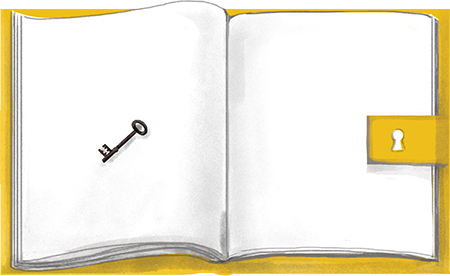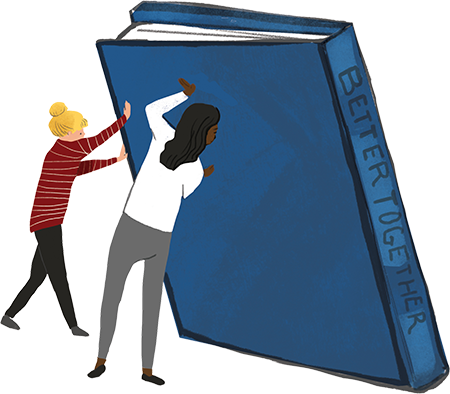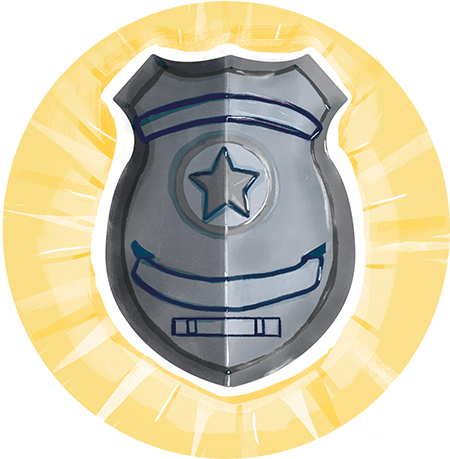Law and order
UofSC researchers bring holistic, proactive approach to criminal justice work
Posted on: January 22, 2019; Updated on: January 22, 2019
By Megan Sexton, msexton@mailbox.sc.edu, 803-777-1421
From an in-depth look at juvenile justice procedures to a mentoring program at an alternative high school, University of South Carolina faculty are conducting research on many aspects of law, order and justice.
Criminal justice research at the university spans multiple programs and colleges, including the College of Arts and Sciences, School of Law and the College of Education. And the work is taking place a few miles from campus and a world away in Uganda.
“When we teach and conduct research beyond the USC campus, we extend the reach of our work,” says Mary Styslinger, an associate professor and researcher in the College of Education. “Our work is enriched through community involvement.”
Here are a few of their stories.
The first step in juvenile justice
The future path for a child accused of a crime is often determined early on — the point at which authorities determine whether prosecuting a particular child serves the system’s overall rehabilitative goals.
Research by Josh Gupta-Kagan, an associate professor of law who specializes in legal issues affecting children and families, explores how the initial charging decisions are made for juvenile offenders.
“It’s a hard question, because there’s a lot of evidence that once you get a kid into the system they’re more likely to stay in the system, commit more crimes and come back,” says Gupta-Kagan, whose work focuses on child welfare and juvenile justice issues. “To fulfill the system’s rehabilitative goals, the system has to be judicious in terms of when it gets involved in a child’s life, because it can actually do more harm than good. Intake is one decision where that comes into play.”
At intake, authorities decide if a case should be prosecuted, diverted or dismissed because it isn’t serious enough to warrant juvenile court involvement.
While these intake decisions play a large role in many juveniles’ futures, the topic has not been thoroughly studied. Gupta-Kagan says there is not a standard practice for how those intake decisions are made in South Carolina or around the country; in some places a prosecutor makes all the decisions, and other locations offer a mix of participants.
Gupta-Kagan, along with fellow UofSC researchers Amanda Fairchild in psychology and Tia Stevens Andersen in criminology and criminal justice, have studied systems in different counties around the state. Their next step will look into whether the system structure makes a difference in which juveniles’ cases are prosecuted, diverted or dismissed.
“The more (juveniles) you get into the system, generally speaking, the worse the outcome. A good amount of research shows diversion is more effective than prosecuting kids at reducing recidivism,” he says.
Gupta-Kagan says he understands some cases are serious and dangerous, and some offenders clearly need to be prosecuted and incarcerated in the juvenile justice system. But he believes misdemeanors such as school fights or small thefts can be better handled through a diversion program. The offenders can receive the same punishment — getting treatment, writing a letter of apology, paying restitution — in a way that that doesn’t brand the juveniles as delinquents, give them a record or make them go through a court proceeding.
“A lot of research shows that’s generally more effective,” he says. “When you look at juvenile justice reform in other states, or when you talk to people with different perspectives, there’s the sense that the system should not be locking kids up for more minor offenses or probation violations. There’s a sense we need to do better distinguishing between cases that don’t really belong in court.”
Gupta-Kagan says he is hopeful the research can help guide policymakers involved in intake procedures.
“Anyone familiar with juvenile justice issues knows these intake decisions are really important and they play out differently depending on where you are,” he says.
Breaking the bonds of illiteracy

There can be no denying the relationship between illiteracy and imprisonment. More than 60 percent of America’s inmates are illiterate, and 85 percent of all juvenile offenders have reading problems.
But there is hope, Styslinger says, as research shows increasing literacy through targeted reading interventions can result in a lesser chance of people returning to jail. Styslinger’s research centers around the relationships between adolescent literacy and the English curriculum, and focuses predominantly on serving marginalized, at-risk and diverse youth.
“Too often, we forget to teach and support reading after elementary school,” she says. “Too often, the English curriculum fails to meet the needs of at-risk and diverse youth. As a result, we have readers at the middle and high school level who struggle to comprehend, or we have readers who are disengaged. We need to provide teachers the strategies necessary to support adolescent comprehension and motivation.”
Understanding the importance of literacy for incarcerated people is particularly important in the U.S., which has the highest prison population rate in the world — with less than 5 percent of the world’s population, the U.S. houses almost 25 percent of the world’s total prison population. In the past 40 years, the prison population in the United States has grown from 250,000 to nearly 2.5 million, and there has been an especially sharp rise in youth incarceration in the past two decades.
Styslinger believes educators, administrators and community members need to be aware of the high rate of youth incarceration and also develop ways to respond to that.
“We have a social responsibility to design curriculum and pedagogy that expands literacy instruction in correctional facilities,” she says. “There are many successful strategies for developing readers and writers while they are incarcerated, which can lead to transformation on both sides of the fence.”
At the S.C. Department of Juvenile Justice, Styslinger has conducted research on the effects of university student teachers reading with incarcerated youth. Another study focused on the effects of book clubs with incarcerated youth. She recently edited a book, “Literacy Behind Bars,” with another South Carolina faculty member, Karen Gavigan in the School of Library and Information Science, which includes best practices and accompanying resources that can be implemented with at-risk youth and adults.
Styslinger ’s 10-year partnership with department’s Birchwood School, located at the agency’s Broad River Road complex in Columbia, has allowed her to merge research, teaching and community outreach.
Each May, UofSC students who are beginning the master’s program in secondary English education split their days learning theory and strategies to support adolescent readers with time reading alongside students from Birchwood. The class, taught by Styslinger on-site at Birchwood, allows her students to see and understand which books motivate the high school students. Styslinger also has organized book clubs at Birchwood school with her doctoral students.
What she has learned is that Birchwood students used the texts they read to critically reflect on themselves and their schools. “They questioned issues of power, particularly the power of literacy in their own lives as well as the power of schools, teachers and curriculum,” she says.
“We also reflected critically on our processes, the challenges and complexities which are inevitable when working with youth in incarcerated settings. This critical lens was vital in helping our students and selves recognize the power of literacy in our lives and research.”
Finding an alternative way through mentoring

Tia Stevens Andersen has three passions — teaching, community service and research.
As an assistant professor of criminology and criminal justice in the College of Arts and Sciences, she is able to combine all three through the Adolescent Mentoring Program she founded in partnership with Lexington School District 2.
The program pairs South Carolina undergrads with students in the Pair Education Center, the district’s alternative high school. Students there have been expelled from their base high school and are at a higher risk of delinquency, school failure, dropping out or involvement with the criminal justice system.
“My research is on juvenile delinquency, risk factors and the negative factors of involvement in the justice system,” Andersen says. “This takes a front-end, preventative approach to keep kids out of the system and put them on the path they’d like to be on.”
The UofSC students begin the semester with intensive mentoring training so they are able to provide high-quality services to the high-schoolers. The training covers a range of topics, from theoretical foundations of mentoring to communication strategies that help them talk to teens about difficult issues. Once the training is complete, the class meets at the alternative school, where each student is matched with a mentee for a relationship that continues through the semester. The pairs also meet up each semester for a community service project; last spring, they helped build a Habitat for Humanity house in Cayce. The idea is to strengthen the schools and communities, she says.
The impact is felt by both the high school students and their college mentors, Andersen says. Many of her students come into the class wanting to become police officers and lawyers; many leave with a changed world view and an interest in a career in human services working with children. For the high school students, Andersen says they comment that they’ve been shown a pathway that most had never considered before.
She will teach the class for the fourth time this fall and has started collecting testimonials from students. In May, when the students came to campus for personalized tours and a celebration ceremony, several of the high school students stood and offered unsolicited comments.
“For some of them it’s the first time they’ve been across the river. For most of them, it’s the first time they’ve been on the USC campus, even though they are growing up in our backyard,” she says. “Some of them said they hated coming to school until they met their mentors. Now they want to come to college. My dream is to have some of them in my class someday.”
Andersen says this is the first formal program she is aware of that provides and studies the use of college students as mentors in alternative schools. She says UofSC will work with the school district to follow the students and will study whether the mentoring procedure helps with graduation rates and future success.
“We have a talented student body of undergraduates and graduate students who want to participate in service learning. It gives them more tools for when they graduate and it harnesses some of their passion for the field.”
Policing the police

Seth Stoughton spent five years as a Tallahassee, Florida, police officer and three as an investigator, gaining a clear understanding of the daily realities of law enforcement.
Now, as a lawyer, professor and legal scholar, he draws on his background to study policing and police officers’ behavior. He says his experience in both jobs gives him the opportunity and the ability to bridge those two worlds.
“It’s like going into your own backyard, but this time you’re looking at it in a totally new way. You get into the grass and look at bugs, look at roots. You see the aspects of something that’s very familiar to you, but in a whole new light,” says Stoughton, an associate professor in the School of Law.
Stoughton researches and writes about policing, conducts police training sessions and is called on frequently to comment on national law enforcement trends and issues.
“I want to introduce to legal scholars and policing scholars some of the working realities that they did not have opportunity to be aware of,” he says. “And I want police chiefs, policymakers, politicians and police leaders to think a little differently about policing and the regulation of policing.”
As a legal academic, he is particularly interested in how police behavior is regulated — the rules in place to make sure officers correctly do their jobs. He looks at how constitutional doctrine, state law and individual police agencies affect the way officers do their jobs and the way they interact with civilians.
“Part of what I am trying to do is change the culture of policing itself,” he says, noting that policing has moved through various eras, from political to professional to community policing. “In each iteration, there’s been successes and notable failures. Part of what I’d like to do is help guide policing into the next era.”
His work also includes teaching and police training, including a course on police law and policy for South Carolina law students.
“I want my students, who are going to be lawyers, to appreciate the complications and complexities of policing and to be very cautious about oversimplifying,” Stoughton says. “Especially as they think about some of the big picture questions like, ‘What role should police play in society?’ but also the very narrow and contextual questions like, ‘What should an officer do in this particular situation?’ If I can get my students to recognize and appreciate those complexities and complications, I think that’s a success.”
The same is true with training police officers. Stoughton says when he conducts officer training, he doesn’t attempt to change officers’ perspectives or world views; instead he is working to get them to critically consider their own perspectives and other perspectives they might not have thought about.
“If that contributes to a change in their world view where they are able to think critically about what they’ve taken for granted in the past and adopt a broader perspective as they think about their job in the future, that’s exactly what I’m trying to do.”
Reconciliation and domestic violence in Uganda
Aparna Polavarapu takes a global look at justice, in its many forms. An assistant professor at the School of Law, she focuses much of her research on issues relating to women’s rights and legal pluralism in sub-Saharan Africa.
Legal pluralism, a term that describes the simultaneous operations of two or more legal traditions in one system, is widely practiced in places like Uganda, where state law and customary law are both regularly applied.
Her recent work focuses on reconciliation, particularly as a mechanism to respond to and prevent domestic violence cases in Uganda. The work is driven by qualitative interviews she did with women, families, lawyers, advocates and others involved in the system on a visit to the country in 2015. Polavarapu, who went to Uganda to research women’s experiences with the justice system, experienced firsthand how reconciliation was used in a criminal context.
In Uganda, all domestic violence victims are able to have the option of pursuing reconciliation. It gives advocates the ability both to help the victims of domestic violence and possibly change the norms of the society.
“Some people push in the U.S. for restorative justice mechanisms, and a lot of those Western theories are drawn from Native American tribes and places in Africa and Asia. In Uganda, this is a unique example because it’s state-sanctioned and nationwide,” she says.
Domestic violence in Uganda means physical, economic and psychological violence cases also are often handled through mediation, meaning the plaintiff and the person charged with committing the abuse meet with community members and advocates. They engage in negotiation that centers on community norms.
“Reconciliation could be ‘we get the parties together and we come to a conclusion.’ But others engage in conferences and try to get a good outcome for the person complaining, who is usually a woman,” she says. “And they’re also engaging in outreach. They are trying to turn restorative justice into transformative justice. They’re trying to make that community-level change.”
Polavarapu says she is particularly interested in studying domestic violence, as it continues to be a significant problem in Uganda and in the U.S.
“I think we have a lot to learn from Uganda. But that really requires forcing a lot of people to pause and think. So much of what has been done for women in Uganda and sub-Saharan Africa has been pushed by Western voices that prioritize state involvement in the criminal justice system,” she says.
“Reconciliation in Uganda gives advocates an opening to not just meet the expressed needs of victims of domestic violence, but to also effect normative change in a way that the formal legal system has failed to do. This is important not just in Uganda, but beyond its borders as well. For example, Western countries, many of which have already seen restorative justice experiments occurring on a smaller scale, can take note of the possibilities available with widespread restorative justice mechanisms.”